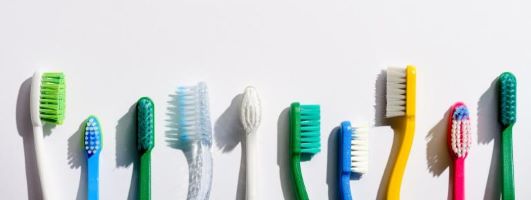Back to Basics: Brushing Tips to Impress Your Dentist

You’ve been brushing for as long as you can remember, but could it be you’ve been doing it incorrectly all along? From the type of bristles you choose to the level of pressure you should place on your teeth, this step-by-step guide to better brushing is chock full of tips to help you get the most out of your dental routine.
Step 1: Pick the right products.
Just as everyone’s dental situation is different, so are the tools necessary to meet your unique health needs. For example, those with tooth sensitivity should stay away from whitening toothpaste and opt for a gentler, enamel — fortifying brand instead. Choosing a brush with softer bristles can also help combat enamel erosion. If gingivitis is a problem, it may benefit you to try a paste or gel designed for tartar control, and pick a brush with varied bristles for help with hard-to-reach areas.
Step 2: Watch the clock.
Timing is everything when it comes to proper hygiene. Most people know that it is important to carve out time in the morning and night to care for teeth, but many don’t realize that the duration of brushing is critically important. Done right, brushing teeth should take approximately two minutes. Any shorter, and you’ve likely skipped a few areas that could develop into problems down the road. To keep you on track, set a timer and watch your pace to make sure every area of your mouth gets enough attention or you can opt for an electronic toothbrush with a timer.
Step 3: Start with hard to reach areas first.
Mapping out a brushing game plan can make a big difference, especially when you find yourself in a rush and/or multi-tasking. Your front teeth may be the easiest to access, but the back molars can be a haven for food particles and starting there can help ensure you clean out the tough spots in case something disrupts your efforts (or, let’s face it, you start to lose focus on the job at hand).
Step 4: Brush up on the proper technique.
You’ve got the time, the tools, and a plan of attack in place — but don’t forget about your technique! Going too hard and too fast not only runs the risk of missing key problem areas, but also it can do some serious damage to your gums and enamel. For a safe and thorough cleaning, hold your toothbrush at a slight angle, and gently brush back and forth. The front of your teeth are hard to miss, but to clear each tooth of plaque buildup, be sure to brush along the gumline and the inside and back surfaces as well.
Step 5: Clean your tongue.
Often overlooked, your tongue houses a ton of oral bacteria responsible for bad breath. Despite its name, your toothbrush works well on tongues too! After you’ve finished brushing your teeth, give your tongue a good cleaning with your toothbrush or a tongue scraper. Your breath will smell better and your palate will feel refreshed.
Step 6: Finish up with floss.
No dental care routine is complete without flossing. Even the best brushing technique can’t get between the tighter spaces of your teeth. To reach every nook and cranny in your mouth, grab some floss and string it gently between and around each tooth. If you find flossing difficult, try one of the many alternatives now available at your local grocery or drugstore: dental pics, interproximal brushes, or water flossers.
Step 7: Choose foods that act as natural scrubbers.
Believe it or not, you can help keep your teeth clean by chewing certain foods. It’s nowhere near a substitute for brushing and flossing, but chomping on crunchy fruits and vegetables can have a brushing effect that minimizes buildup. Another simple way to help prohibit the growth of oral bacteria is to chew sugar-free gum that contains xylitol.
Share the News with Your Dentist
Last, but not least, let your dentist in on your new brushing skills. Keeping her appraised on your efforts and products that work (or don’t work) for you may, in turn, affect your treatment plan, and/or result in prescribed dental products and additional guidance to help you achieve your oral health goals.
Sources:
Grant, L. (2014, July 22). The Truth About Healthy Teeth: At-Home Dental Care. Retrieved June 1, 2015 from http://www.webmd.com/oral-health/healthy-teeth-14/brushing-teeth-mistakes
How to Brush. (2006, June 12). Retrieved June 1, 2015 from http://www.colgate.com/app/Colgate/US/HomePage.cvsp